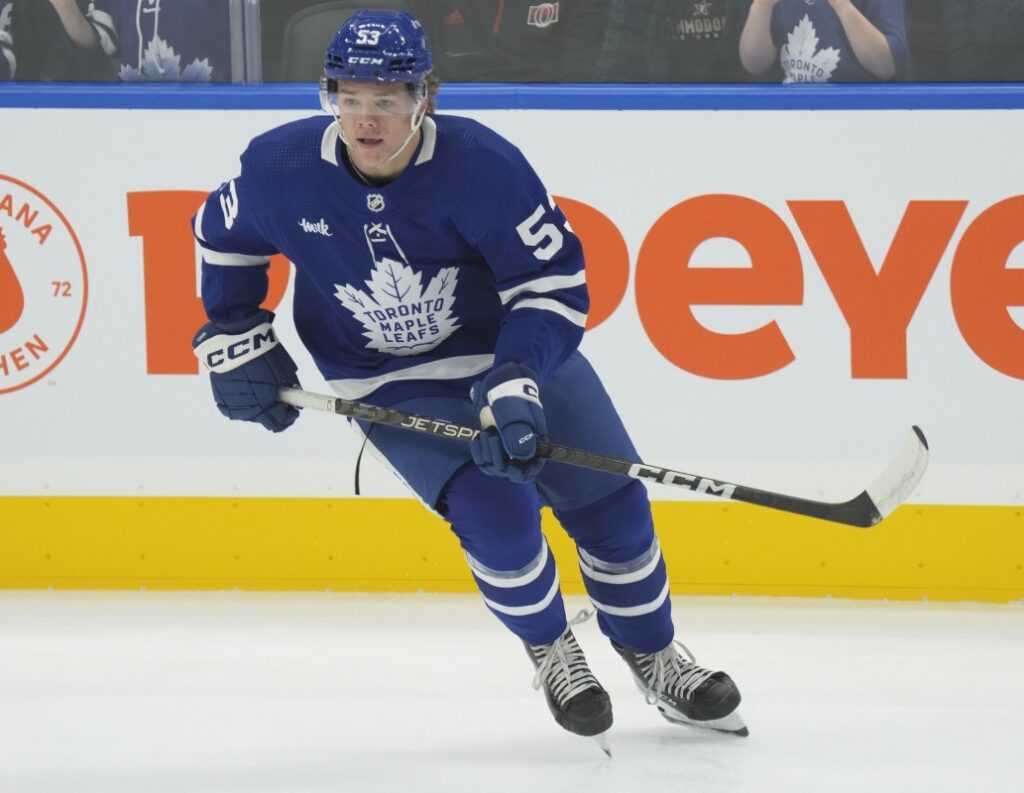The NHL and CHL transfer agreement prevents drafted major junior players from playing in the AHL full-time.
As THN editor-in-chief Ryan Kennedy reported, there could be a move to change that for 19-year-olds.
And frankly, we think it’s an evolution whose time has come.
Anyone making the argument that 19-year-olds are somehow too delicate and underdeveloped to deal with the rigors of professional hockey is ignoring the fact that the major junior hockey level is basically a pro league unto itself. Eighteen and 19-year-old players put themselves through lengthy bus rides, and perform in front of thousands of fans who pay significant costs for tickets to games in the OHL, WHL and QMJHL. How is that any different in the AHL? To ask it is to answer it. There is no difference.
Related: Matt Rempe Heads To AHL As Fighting Drops, And It’s The Star Players Who Might Not Be Happy: ‘It’s An Entertaining Part Of The Game’
For some time now, we’ve been seeing changes throughout elite amateur sport that acknowledges the big-business element of the product. In the NCAA, athletes are now paid for their name, image and likeness (NIL) – a huge step forward for fair pay for the hard work and sacrifice they put into their chosen line of work. Similarly, if young hockey players are mature enough to play at hockey’s top level as 18-year-olds, surely they can do the same one level down in the AHL.
There are more than a few examples of 19-year-olds who should’ve been in the AHL rather than returning to the CHL as an older player. Last season, Maple Leafs prospect center Fraser Minten had a solid showing at Leafs training camp, but after a four-game NHL stint with no points, he was returned to junior hockey and posted 22 goals and 48 points in 43 games in the WHL. He easily could’ve and would’ve been sent to the AHL’s Toronto Marlies if he were a year older.
Similarly, Edmonton Oilers prospect Matthew Savoie had a one-game stint as a member of the Buffalo Sabres, and he had a six-game conditioning stint with AHL Rochester, where he generated two goals and five points. But he was then sent back to the WHL, where he put up a whopping 30 goals and 71 points in 34 games. Savoie is small in physical stature, but his skills are elite, and that’s why he would’ve been better served to be in the AHL last season.
Another example is a current one. Leafs prospect Easton Cowan is currently in the OHL as a 19-year-old with the London Knights. He probably could’ve played in the AHL last season as an 18-year-old, as he posted 62 assists and 96 points in 54 games. And while Cowan didn’t have a particularly impressive NHL training camp with the Leafs this fall, there was no choice but to send him back to London for the current season. Predictably, Cowan has three goals and six points in five games for the Knights this year. He’s still physically growing, but he needs more experience playing with grown men if he’s to make the jump to the NHL anytime soon. He should’ve been able to get that experience in the AHL, if not last season, then certainly this year.
Easton Cowan scored a power-play goal in a 3-1 win against Erie on Sunday to extend his regular-season point streak to 41 games.
He centered a line with Jacob Julien and Cohen Bidgood, going 8-for-17 on the dot.
Totals (OHL): 5 GP, 3 G, 6 PTS, 22 SOG#LeafsForever pic.twitter.com/F7o2J7ca5d
— Kyle Cushman (@Kyle_Cush) October 21, 2024
This is why continuing to prevent 19-year-olds in major junior from entering the AHL can’t be justified. Players and their representatives know that teams are profiting off their backs, and they have a right to ply their trade the same way a player only one year older than them does.
Now, this isn’t to say every 19-year-old should force their team’s hand and demand they be inserted in the AHL. Some young players simply aren’t mature enough, physically or mentally, to make that jump as a 19-year-old. But there has to be an option for players who are mature enough. Some youngsters will benefit greatly from the challenge of playing against full-grown adults, and there’s nothing inherently wrong with wanting to take that challenge.
The professional sports world is always evolving. There may have been a time when 19-year-olds were taking their well-being into their own hands by competing against much older individuals who had different agendas than just competing against the best talent available to them. But young players now are fully aware of what they’re getting themselves into at the AHL level. They’re locked in as elite athletes at a very early age, and their year-round training has many, if not most of them able to hang with 20-year-olds and older players.
And so long as they’re able to persuade coaches and GMs that they’re ready to step in and do battle at the professional level, those youngsters deserve the opportunity to do so. As time moves forward, leagues need to adjust and adapt, and bringing 19-year-olds into the AHL game is a move that should be adopted as soon as possible.
Correction: The article was adjusted to reflect the CHL/NHL transfer agreement preventing 19-year-olds from playing in the AHL full-time, not an AHL rule. We apologize for the error.
Read the full article here



